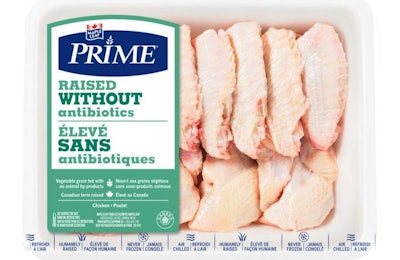
As Maple Leaf Foods starts to begin the production of saleable products at its new value-added poultry plant in London, Ontario, the company has so far found the hiring process to go rather smoothly.
In late September, the Canadian meat and poultry company announced that it had completed the construction of the new 660,000 square-foot plant. Once the new plant is fully online, the company will phase out production at the plants in St. Marys, Toronto and Brampton, all of which are also in Ontario.
Speaking during a conference call on November 8, in which Maple Leaf Foods released its financial results for the third quarter of fiscal year 2022, Chief Operating Officer Curtis Frank gave an update on the ramp-up of the facility, including the hiring process.
“We’re in excellent condition in the London facility for start-up with respect to labor,” Frank said. “We’ve got a great leadership team there. They’ve been onboarding people at a pace that is exactly in line, if not ahead of the schedule that we had predicted.”
At the present time, equipment testing has begun at the London plant and new people have been hired. Production of saleable products is set to begin within the next few weeks.
“From there, we will start to ramp up by carefully transferring production from our St. Mary’s, Toronto and Brampton facilities in sequence, and then closing those legacy facilities in due course,” Frank said.
Frank said by the end of 2022, about 600 team members will be employed at the plant, of which 350 of them will be transferred from the St. Mary’s plant. The plant will ultimately employ about 1,600 people when it reaches full capacity.
Frank is optimistic after those 350 St. Marys employees transfer, the company will also see some of its Toronto-based employees transfer, even though Frank acknowledged the company was “not counting on large numbers.”
“The opportunity to work in a world-class scale, technologically sound, and very safe facility has been very attractive to our people,” he said.
He said Maple Leaf Foods has been engaged in the temporary foreign worker program “in a pretty material and meaningful way,” and the company expects to get several hundred new workers through that program.
Companywide employee recruitment
Frank acknowledged that not that long ago, Maple Leaf Foods, which employs about 14,000 people companywide when fully staffed, was struggling to fill positions.
“Like many other business, over the past few quarters we have been hamstrung by a shortage of workers. We estimate the cost of vacancies during Q3 was roughly CA$15 million,” he said, adding that those costs show up through things such as overtime, the use of temporary worker agencies, the loss of operating efficiencies and short shipments to customers.
But things are turning around, Frank said.
“I see us in green light status. We responded aggressively by ramping up recruitment and retention, by initiating a variety of focus programs such as solving commuting challenges, attracting recruits through social media, and leveraging the foreign worker program. This hard work is now paying off. In Q2, our vacancies had peaked at over 1,500 employees. At the end of September, our vacancies were around 900, and with today’s programs, we are now down to around 600 vacancies in our network.”
Also during the earnings call, company executives offered an update on how the company is responding to a recent cybersecurity attack.


















